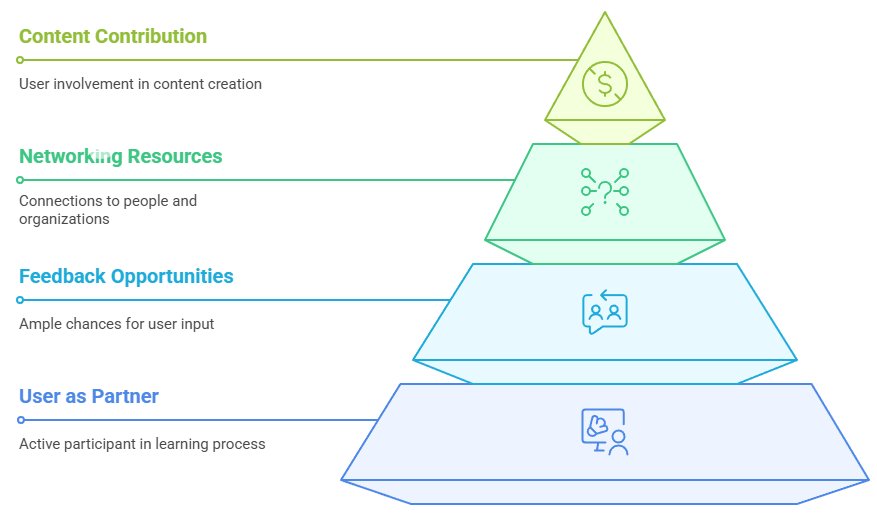 |
Hari Srinivas |
|
Policy Analysis Series E-083. April 2015.
|
Abstract
This paper highlights the critical role of user analysis in designing effective knowledge management systems. It argues that a successful system integrates various learning technologies and methods to address specific user needs and organizational goals. Central to this approach is viewing users as active partners rather than passive recipients. The paper outlines key components of user analysis, including target identification, needs assessment, packaging of information, marketing, delivery modalities, support systems, and monitoring and evaluation.
Emphasis is placed on creating interactive, dynamic, and adaptable knowledge products that promote continuous learning, collaboration, and user engagement. Such systems ensure that knowledge is accessible, relevant, and actionable, ultimately enhancing the impact of knowledge initiatives.
Keywords
knowledge management, user analysis, needs assessment, e-learning, information packaging, knowledge delivery, support systems, monitoring and evaluation
|
A good knowledge management system has the right combination of different learning technologies and training methodologies to meet the specific learning needs of an individual or organization and help achieve their goals. This combination can include self-paced and live learning experiences over the Web or other electronic media, traditional instructor-led training, and other forms of instruction.
The key defining criteria for knowledge products and services is the needs of the end-user. Some basic issues and principles for developing learning products have looked at the user as a partner in the learning process, and not just a passive receiver. This is done by providing ample opportunity for feedback; opportunities for the user to network and find new people, organizations and institutions, and resources; opportunities to also contribute to the contents of the e-learning packages, etc.
 Figure 1: User-Centric Learning and Development
Figure 1: User-Centric Learning and Development
This kind of user's needs analysis is an important pre-requisite for the development of a good knowledge system. The table below outlines some of the issues to be considered:
|
Aspect | Issues
| |
Target Identification
|
- Who is the eventual end-user?
- What level does the end-user operate?
- What is the scope of activities of the end-user?
- What networks bring the end-users together?
- What local institutions/organizations work with the end-user?
- What does the organization's mandate and other guiding documents say of the end-user?
| |
Needs Assessment
|
Besides the above points,
- What are the end-users' targets?
- What are the end-user's objectives and goals?
- What will be included in a needs-assessment questionnaire (keeping in mind that these assessment change depending on the end-users' targets, on the time scale, and scope/level of operation)?
| |
Packaging Information
|
- How can existing projects be 'redesigned' to generate info for e-learning products?
- How will the above needs assessment exercise help in identifying the format of the e-learning package?
- How can different information packages be developed from the same block of data/information of a project?
- How can the information format be matched with the differing needs of the end-user?
- How can the subsidiary of information be maintained - delivering the right info at the right time to the right level and the right end-user?
| |
Marketing
|
- How can the info on knowledge products be delivered to the end-user?
- What events (external and internal to the organization) can be used to disseminate knoledge meta-info, both online and offline?
- How can effective networking by the organization's staff serve the timely delivery of knowledge products?
| |
Delivery Modalities
|
- What appropriate information infrastructure needs to be developed for knowledge management: online and offline?
- What components of knowledge products need to be on-line and what components need to be offline (electronic and hardcopy)?
- Depending on the target end-user, what will be the frequency, format and mode of delivery of the knowledge products?
| |
Support Systems
|
- Besides the main knowledge product, what kinds of support systems need to be put in place: ongoing - during the course of learning; and follow-up - as a continuous learning exercise?
- What kinds of value-added resources need to be delivered to the main e-learning product in order to make it more relevant to different end-users - 'individualized' or 'regionalized'?
- How will queries and comments/suggestions etc. from users be processed? How will it be used to enhance the quality of knowledge products/processes?
| |
Monitoring and Evaluation
|
- What will be the components of a M&E system?
- Monitoring the end-user's use of the knowledge product itself
- Monitoring the end-user's use of knowledge gained
- Assessment of the quality/quantity of information/knowledge provided in the knowledge package
|
A well-designed knowledge management system is not just about delivering information; it is about creating an interactive and dynamic learning experience tailored to the needs of the end-user. By considering the various aspects of user analysis - such as target identification, needs assessment, information packaging, marketing, delivery modalities, support systems, and monitoring and evaluation - organizations can develop more effective and user-centric knowledge products.
Ultimately, the success of a knowledge management system lies in its ability to foster continuous learning, encourage collaboration, and ensure that knowledge is accessible, relevant, and actionable. By prioritizing user engagement and adaptability, organizations can enhance the impact of their knowledge initiatives and contribute to a more informed and empowered audience.
|

 Hari Srinivas - hsrinivas@gdrc.org
Hari Srinivas - hsrinivas@gdrc.org